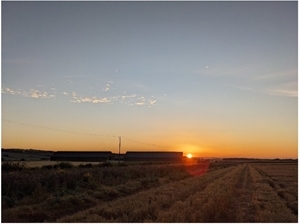Written by Isabella Allan, Scottish Lowlands Research placement student
Over the last few weeks, the Scottish Lowlands team has been busy completing the tenth year of spring grey partridge pair surveys on Balgonie farm.
 One of the largest fields on Balgonie farm, yet to be surveyed. (Credit: Isabella Allan)
One of the largest fields on Balgonie farm, yet to be surveyed. (Credit: Isabella Allan)
Surveying partridges involves driving or walking round each field, up and down every other tramline, until you have covered your full survey area. Ideally, this will be done two or three times to ensure an accurate count. These counts can only be done in good weather, with little to no rain and wind speeds under 18 miles per hour. These conditions are very hard to find in Fife, where Balgonie is located, so the team have to be flexible and ready to change a survey at short notice.
 A view of a family of pheasants from the survey vehicle window. (Credit: Isabella Allan)
A view of a family of pheasants from the survey vehicle window. (Credit: Isabella Allan)
The surveys must be done during the three hours after sunrise and the three hours before sunset. This can result in some long working days, but also the opportunity to spend time on the farm at the most beautiful times of day. The songbirds are out singing, and the sky is always filled with a beautiful colours. Mornings tend to be bright, with the last of the crepuscular wildlife sneaking away, and evenings are filled with rich golden sunshine with plenty of pinks and oranges.


Left: Rainbow over an oilseed rape field on Balgonie farm in the early morning. (Credit: Isabella Allan)
Right: sunset over Balgonie. (Credit: Isabella Allan)
We are lucky enough to see lots of wildlife – in addition to the grey partridges, of course – including hares, foxes, yellowhammers, kestrels, meadow pipits, skylarks, starlings, swallows, chiff chaffs, and many more. It is a wonderful feeling to be out alone on the farm in the early morning, surrounded by a cacophony of birdsong, occasionally interrupted by the ‘kut kut kut’ alarm call of a grey partridge.
 A pair of grey partridges taken through binoculars. The partridges are
A pair of grey partridges taken through binoculars. The partridges are
well camouflaged and difficult to photograph! (Credit: Isabella Allan)
Despite a couple of setbacks, including the gear stick coming off the survey vehicle halfway through a morning survey, we have managed to see around 40 pairs of partridges on Balgonie this spring. This is a similar number to the amount seen over the last few years, with 35 seen in 2023 and 37 seen in 2022. We are looking forward to the next round of counts, which will take place in autumn and will include the new round of grey partridge chicks that these pairs will raise. Grey partridges lay the most eggs of any bird (up to 19!), and are very good parents, so we are looking forward to seeing some large, healthy coveys within the next few months.